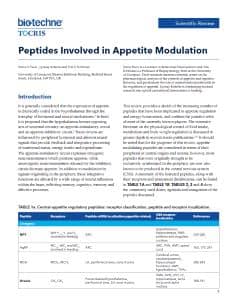δ Opioid Receptors
The δ opioid receptor (also known as OP1, DOP, DOR) is a member of the opioid family of G-protein-coupled receptors that also includes μ, κ and NOP receptors. In the CNS, δ opioid receptors are primarily distributed in the olfactory bulb, nucleus accumbens and neocortex.
δ Opioid Receptor Agonists |
|
|---|---|
| Cat. No. | Product Name / Activity |
| 1180 | [D-Ala2]-Deltorphin II |
| Selective δ agonist peptide | |
| 1431 | DPDPE |
| Selective δ agonist | |
| 0921 | SB 205607 dihydrobromide |
| Selective, high affinity non-peptide δ1 agonist | |
| 1529 | SNC 162 |
| Potent, selective non-peptide δ agonist | |
| 0764 | SNC 80 |
| Highly selective non-peptide δ agonist | |
δ Opioid Receptor Antagonists |
|
| Cat. No. | Product Name / Activity |
| 0820 | ICI 174,864 |
| δ selective peptide antagonist | |
δ Opioid Receptor Modulators |
|
| Cat. No. | Product Name / Activity |
| 5983 | BMS 986187 |
| Potent positive allosteric modulator of δ receptors | |
The δ opioid receptor (also known as OP1, DOP, DOR) is a member of the opioid family of G-protein-coupled receptors that also includes μ, κ and NOP receptors. In the CNS, δ opioid receptors are primarily distributed in the olfactory bulb, nucleus accumbens, caudate putamen and neocortex, with low-moderate levels present in the thalamus, hypothalamus and brainstem.
δ opioid receptors play a role in analgesia, motor integration, gastrointestinal motility, olfaction, respiration, cognitive function and mood driven behavior. The enkephalins are generally considered to be the preferred endogenous ligands. The human gene encoding the δ opioid receptor has been localized to chromosome 1 (1p36.1-p34.3).
External sources of pharmacological information for δ Opioid Receptors :
Literature for δ Opioid Receptors
Tocris offers the following scientific literature for δ Opioid Receptors to showcase our products. We invite you to request* your copy today!
*Please note that Tocris will only send literature to established scientific business / institute addresses.
Peptides Involved in Appetite Modulation Scientific Review
Written by Sonia Tucci, Lynsay Kobelis and Tim Kirkham, this review provides a synopsis of the increasing number of peptides that have been implicated in appetite regulation and energy homeostasis; putative roles of the major peptides are outlined and compounds available from Tocris are listed.
Addiction Poster
The key feature of drug addiction is the inability to stop using a drug despite clear evidence of harm. This poster describes the brain circuits associated with addiction, and provides an overview of the main classes of addictive drugs and the neurotransmitter systems that they target.

